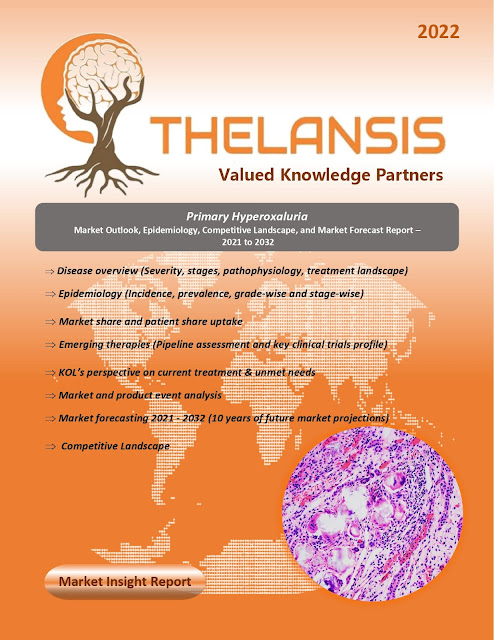Primary Hyperoxaluria – Market Outlook, Epidemiology, Competitive Landscape, and Market Forecast Report – 2021 To 2032
Primary hyperoxalurias are inborn errors in glyoxylate and oxalate metabolism. They are characterized by excessive oxalate production, a metabolic emend product. The most common type of PH, PH1, is caused by a deficiency of the liver-specific peroxisomal, pyridoxal phosphate-dependent enzyme alanine: glyoxylate aminotransferase. The second type, PH2 is caused by a deficiency in glyoxylate reductase/ hydroxypyruvate reductase, a cytosolic enzyme. The recently identified PH type 3 is linked to the gene DHDPSL, encoding a mitochondrial enzyme, although the metabolic reactions involved remain to be confirmed. Including AGXT, over twenty-five different mutations have been identified so far, and around 30% of patients have the G630A mutations leading to Gly170A amino-acid substitutions. Primary hyperoxaluria types 1, 2, and 3 are caused by mutations in the AGXT, GRHPR, and HOGA1 genes. These genes provide instructions for making enzymes that help with the breakdown and processing of protein building blocks and other compounds.
·
Primary Hyperoxaluria in the United States is
approximately 1:58,000. PH3 was predicted to be as prevalent as PH1 and twice
as common as PH2, indicating that PH3 (and PH2) cases are underdiagnosed and/or
incompletely penetrant.
·
As per the registry, most PH patients had PH
Type 1, followed by PH Type 2 and PH Type 3. Maximum patients had their first
symptom between the ages of 0-4, 5-9, and 10-19.
Thelansis’s “Primary Hyperoxaluria
Market Outlook, Epidemiology, Competitive
Landscape, and Market Forecast Report – 2021 To 2032" covers disease
overview, epidemiology, drug utilization, prescription share analysis,
competitive landscape, clinical practice, regulatory landscape, patient share,
market uptake, market forecast, and key market insights under the potential Primary
Hyperoxaluria treatment modalities options for eight major markets (USA,
Germany, France, Italy, Spain, UK, Japan, and China).
KOLs insights
of Primary Hyperoxaluria across 8 MM market from the centre of Excellence/
Public/ Private hospitals participated in the study. Insights around current
treatment landscape, epidemiology, clinical characteristics, future treatment
paradigm, and Unmet needs.
Primary Hyperoxaluria Market Forecast Patient
Based Forecast Model (MS. Excel Based Automated Dashboard), which Data Inputs
with sourcing, Market Event, and Product Event, Country specific Forecast
Model, Market uptake and patient share uptake, Attribute Analysis, Analog
Analysis, Disease burden, and pricing scenario, Summary, and Insights.
Thelansis Competitive Intelligence (CI) practice
has been established based on a deep understanding of the pharma/biotech
business environment to provide an optimized support system to all levels of
the decision-making process. It enables business leaders in forward-thinking
and proactive decision-making. Thelansis supports scientific and commercial
teams in seamless CI support by creating an AI/ ML-based technology-driven
platform that manages the data flow from primary and secondary sources.




Comments
Post a Comment